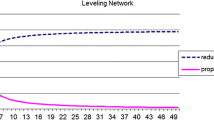Abstract
This study aims to investigate the ability of different least squares adjustment techniques for detecting deformation. A simulated geodetic netwo rk is used for this purpose. The observations are collected using the Total Station instrument in three epochs and different least squares adjustment methods are used to analyze the simulated network. The applied methods are adjustment-byelement, using variance-covariance components and Tikhonov regularization. For numerical computation, we utilized exist geodetic network around the simulated network and the deformation (changes in the simulated network) imposes to the object using a simulator in each epoch. The obtained results demonstrate that more accurate outcome for detection of small deformation is possible by estimating variance-covariance components. The difference of the estimated and the simulated deformations in the best scenario, i.e., applying variance-covariance components, is 0.2 and 0.1 mm in x and y directions. In comparison with adjustment by element and Tikhonov regularization methods the differences are 1.1 and 0.1 in x direction and 1.4 and 1.1 mm in y direction, respectively. In addition, it is also possible to model the deformation and therefore it can be seen that how the calculated displacement will affect the result of deformation modelling. It has been demonstrated that determining reasonable variance-covariance components is very important to estimate realistic deformation model and monitoring the geodetic networks.
Similar content being viewed by others
References
Beshr, A. A. El.-W. and Kaloop, M. R. (2013). “Monitoring bridge deformation using auto-correlation adjustment technique for total station observations.” Positioning, Vol. 4, No. 1, pp. 1–7, DOI: 10.4236/pos.2013.41001.
Bjerhammar, A. (1973). Theory of errors and generalized matrix inverses, Elsevier.
Bouman, J. (1998). Quality of regularization methods, DEOS Report no. 98.2, Delft University Press.
Chen, Y. Q. (1983). Analysis of deformation surveys — A generalized method, Technical Report No. 94, Department of Surveying Engineering, University of New Brunswick, Fredericton, N.B.
Chrzanowski, A., Chen, Y. Q., and Secord, J. M. (1983). “On thestrain analysis of tectonic movements using faultcrossing geodetic surveys.” Tectonophysics, Vol. 97, Issues 1–4, pp. 297–315.
Cosser, E., Roberts, G. W., Xiaolin Meng, and Dodson, A. H. (2003). “Measuring the dynamic deformation of bridges using a total stations.” Proceedings, 11th FIG Symposium on Deformation Measurements, Santorini, Greece.
Ditmar, P., Kusche, J., and Klees, R. (2003). “Computation of spherical harmonics coefficients from gravity gradiometry data to be acquired by the GOCE satellite: regularization issues.” J Geod., Vol. 77, Issues 7–8, pp. 465–477.
Fan, H. (2006). Theory of errors and least squares adjustment, Royal Institute of Technology (KTH).
Grafarend, E., Kleusberg, A., and Schaffrin, B. (1980). “An introduction to the variance and covariance component estimation of helmert type.” ZfV, Vol. 105, No. 4, 1980, pp. 161–180.
Hansen, P. C. (1998). Rank-Deficient and discrete ill-posed problems, SIAM monographs on mathematical modeling and computation.
Hansen, P. C. (2008). Regularization Tools version 4.0 for Matlab 7.3, Numerical Algorithms, Vol. 46, pp. 189–194.
HMK-Ge:S. (1996). Handbok i mät-och kartfrågor, Geodesi Stommätning. Gävle: Lantmäteriet.
Hill, C. D. and Sippel, K. D. (2002). Modern deformation monitoring: a multi sensor approach, FIG XXII International Congress, Washington DC, USA.
Junhuan, P., Shi Yun, Li Shuhui, and Yang Honglei (2011). “Minque of Variance-Covariance Components in Linear Gauss-Markov Models.” Journal of Surveying Engineering, DOI: 10.1061/(ASCE)SU.1943-5428.0000050.
Kaloop, M. R. and Li, H. (2009). “Monitoring of bridge deformation using GPS technique.” KSCE Journal of Civil Engineering, Vol. 13, Issue 6, pp. 423–431, DOI: 10.1007/s12205-009-0423-y.
Kuang, S. L. (1991). Optimization and design of deformation monitoring schemes, Technical Report No. 157. PhD Thesis, Department of Surveying Eng. University of New Brunswick, Canada.
Kuang, S. L. (1996). Geodetic network analysis and optimum design: concepts and applications, Ann Arbor Press, Inc., Chelsea, Michigan.
Meng, X. (2002). Real-time deformation monitoring of bridges using GPS/accelerometers, PhD Thesis, University of Nottingham, Nottingham, UK.
Radovanovic, R. S. and Teskey, W. F. (2001). “Dynamic monitoring of deforming structures: GPS verses robotic tacheometry systems.” The 10th FIG International Symposium on Deformation Measurements, Orange, California, USA, pp. 61–70.
Rao, C. R. and Mitra, S. K. (1971). Generalized inverse of matrices and its applications, New York: Wiley.
Rao, C. R. (1973). Linear statistical inference and its applications, 2nd edition, John Wiley & Sons.
Raziq, N. and Collier, P. (2007). GPS deflection monitoring of the west gate bridge, 3rd IAG / 12th FIG Symposium, Baden, May 22-24, 2006.
Setan, H. and Singh, R. (2001). Deformation analysis of a geodetic monitoring network. Geomatica, Vol. 55, No. 3.
Sjöberg, L. E. (1983). Unbaised estimation of variance-covariance components in condition adjustment, Department of Geodesy, Uppsala University, Report No. 19.
Sokolnikoff, I. S. (1956). Mathematical theory of elasticity, McGraw-Hill, New York.
Tikhonov, A. N. (1963). Solution of incorrectly formulated problems and regularization method, Soviet Math. Dokl., 4: 1035–1038, English translation of Dokl. Akad. Nauk. SSSR 151, pp. 501–504.
Author information
Authors and Affiliations
Corresponding author
Rights and permissions
About this article
Cite this article
Bagherbandi, M. Deformation monitoring using different least squares adjustment methods: A simulated study. KSCE J Civ Eng 20, 855–862 (2016). https://doi.org/10.1007/s12205-015-0454-5
Received:
Accepted:
Published:
Issue Date:
DOI: https://doi.org/10.1007/s12205-015-0454-5




